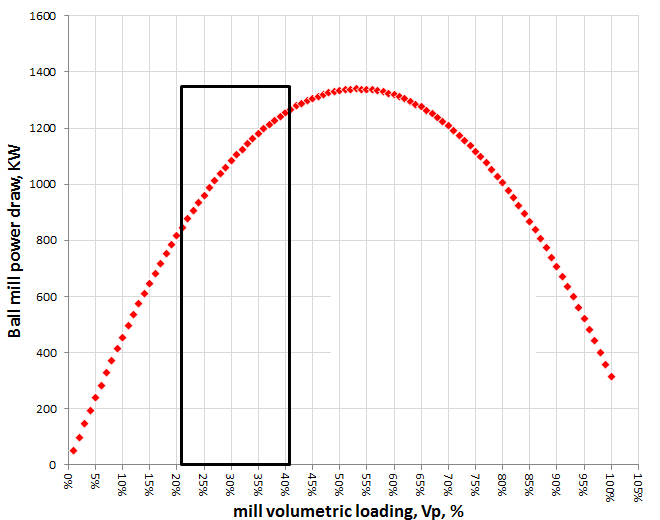- To participate in the 911Metallurgist Forums, be sure to JOIN & LOGIN
- Use Add New Topic to ask a New Question/Discussion about Grinding.
- OR Select a Topic that Interests you.
- Use Add Reply = to Reply/Participate in a Topic/Discussion (most frequent).
Using Add Reply allows you to Attach Images or PDF files and provide a more complete input. - Use Add Comment = to comment on someone else’s Reply in an already active Topic/Discussion.
How Steel Charge affects Ball Mill Power Draw (4 replies)
The power you are measuring is probably from the INPUT to the motor? This is what you get if you measure the RMS voltage and current in the electrical network ahead of the motor.
The rated OUTPUT power is usually what you are referring to when you say "the motor is 1500 HP".
The motor efficiency (in the simplest form) is equal to the power measured at the output divided by the power measured at the input. The input power is always higher as you have electrical (and possibly mechanical) energy losses in the drive system. If your motor has an efficiency of 0.9 and you measure 1000 kW at the motor input, then the motor output power you would measure (with a torque device) is 900 kW. This is why you are measuring more input power than the rated power; the rated "input" power would be 1500 HP divided by the motor efficiency. In this example, 1500 HP ÷ 0.90 = 1667 HP at the motor input. The maximum your motor can "input" is 1667 HP, equal to 1500 HP at the "output".
I'll leave someone else to answer your other question. My opinion is it is unlikely your power model is correct if it predicts maximum power draw at 50% vol filling.
Not sure on your calculation method. Have you tried this calculator: https://www.911metallurgist.com/blog/ball-mill-motorpower-sizing-calculation
Hello Roy, we would need a few more details from your mill specs, etc., to verify your model calculations. As Alex said, you power model might be correct. But here are answers to your questions:
If the motor output power is measured/calculated to be 1,509 HP, and the rated output power is 1,500 HP, then yes, you are drawing very slightly more than the motor is designed for. It might overheat, eventually (depending on ambient conditions). And you are cutting into the mechanical design factors (for example, the shaft torque at full motor load may be X, but it is designed for 2X, perhaps.
Just like a crane hook designed for 1500 kilos, it is not likely to fail at 1501 kilos). Motor manufacturers sometimes uprate original design output, if, for example, cooling is added. But without their OK, you should not run above the rated output.
No, it is not normal to operate above 40 to 45% charge level. Unless the trunnion is very small or unless you are using a grate discharge ball mill, balls will not stay in the mill, and you will spend a lot on steel to add a small amount of power. Formulas given for mill power draw modelling are empirical, and fit around field data over the normal operating range of about 30 to 45% charge level. Theoretically, power draw maximizes at 50% charge level, and actually returns to zero at 100% charge level as the mill becomes a flywheel.
Thanks everyone. I realize I had forgotten to detect the mill liners from my mill's dimensions. Therefore yes, my model was incorrect. This change results in a in the diameter going from 13.5 ft to 13 ft = a power-draw change from 1509 to 1368 HP.
My "nameplate" 1500 HP motor = 1118 kW
I know of 2 methods:
Motor output power KW = Motor input power x Rated motor efficiency
Motor output power KW = 0.001 x (1.73 x amperage x voltage x power factor) x Rated motor efficiency/
Our power factor is 0.99 electricians tell me. My ball load measured using exposed liner count comes in at around 32% and my power-draw at 1084 kW.
This method depend on the accuracy of our measurement (we might need to subtract the liner thickness).
Below empirical model says max power draw obtained at 50% volumetric loading. We can't fully believe this graph model. I think this empirical model only gives accurate readings up to 40% volumetric loading range.

I suppose I can load more steel and draw more power to my ball mill. Maybe up to 35-37% load.

Yesterday I calculated the power draw of our ball mill. I attach a graph of it.
Is it possible to have calculated mill power draw to be greater than mill motor HP?
According to the calculations, at 54% mill volumetric loading, max power draw of 1,796 HP is obtained. Is it practical to achieve this?
Thank you.